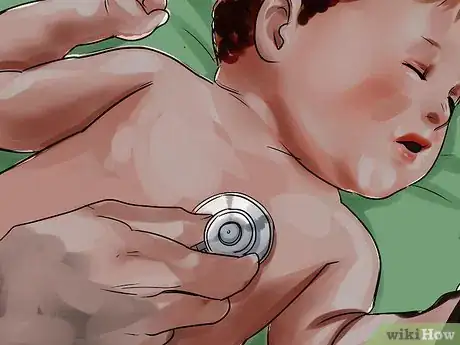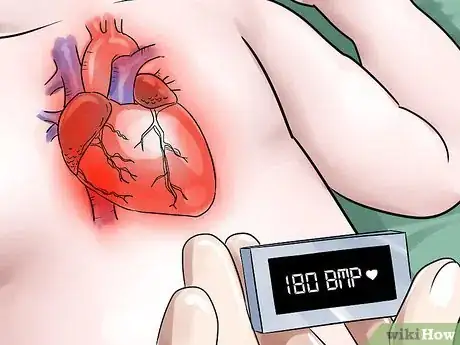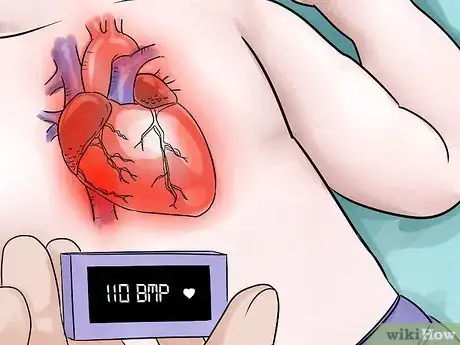This article was co-authored by Joel Warsh, MD. Dr. Joel Warsh is a board certified Pediatrician and the Owner & Founder of Integrative Pediatrics and Medicine in Los Angeles, California. With over a decade of experience, Dr. Warsh specializes in holistic and integrative medicine. He holds a Bachelor’s degree in Kinesiology and Health Sciences, a Master’s degree in Epidemiology and Community Health, and a Doctor of Medicine (MD) from Thomas Jefferson Medical College, where he was elected president of the Jefferson Pediatric Society. Dr. Warsh then completed his Pediatric Residency at Children’s Hospital of Los Angeles (CHLA), where he received the George Donnell Society Research Fellow.
There are 7 references cited in this article, which can be found at the bottom of the page.
This article has been viewed 57,518 times.
Heart rate, which is also known as pulse rate is defined as the number of times the heart beats in one full minute. Infants generally have higher pulse rates than adults; they're heart rates generally fall between 140 and 160 beats per minute, even at rest.[1] Infants have higher pulse rates because their bodies are growing rapidly, which causes their metabolism to be high. When a person or infant has a fast metabolism, the body requires more oxygen to pump out the carbon dioxide in the body; this is achieved by an increase in the heart rate.
Steps
Taking an Infant's Pulse Rate
-
1Find the areas where the infant's pulse is strongest. An infant's pulse is stronger in the apical area, or left part, of the chest near the heart.[2] You can choose any of the two in taking an infant's pulse.
- It is also strong in the brachial area, or the inner bend of the arm at the back of the elbow.
-
2Wash your hands. Infants have weaker immune systems than adults. Because of this, is it important that you rinse your hands with warm water and antibacterial soap. This will help to prevent you from transmitting any harmful microorganisms to the infant.Advertisement
-
3Prepare the necessary materials. When taking an infant's pulse rate, it is helpful to use a stethoscope to allow you to hear the pulse. A stethoscope can be purchased at your local pharmacy. You will also need:
- A watch that counts seconds.
- Pen and paper.
-
4Place the infant on his or her back. Doing this will help to keep the infant's pulse rate from increasing, which could throw off the accuracy of your results. You can place the child between two pillows so that she cannot roll away, or you can ask someone to hold the infant on her back while you take the reading.[3]
- When an infant is placed in a vertical position, blood flows to the lower extremities due to the force of gravity, which causes the heart to beat faster. The heart beats faster because the heart has to work harder to pump blood to the different parts of the body.[4]
-
5Make sure that the infant is not crying before taking the pulse. Extreme emotions activate the sympathetic nervous system (a part of the brain that increases vital signs such as the heart rate, breathing and blood pressure). As a result, if the infant is unhappy, the heart rate will increase suddenly.[5]
- If the infant begins to cry, soothe her and wait for her to calm down before you try taking her pulse.
-
6Locate the apical pulse. If the baby is wearing a dress or shirt with Velcro straps or ties, undo these so that you can expose the baby's chest without removing the entire dress. To find the apical pulse[6] :
- Place your pointer finger on the middle part of the baby's left clavicle, or collarbone (this is the long bone in the chest that is near the shoulder blade).
- Glide your finger down slowly to locate the first intercostal space (this refers to the space between each rib).
- Move down to the second and third intercostal space, until you reach the fourth space. This is where you should be able to feel the apical pulse most strongly. This spot is known as the spot of maximal impulse.
-
7Place your stethoscope on the baby's chest. Warm the stethoscope up by placing the large metal circle (this is known as the diaphragm) in the palm of your hand for at least 10 seconds.
- Warning up the diaphragm will help to keep the infant from being startled by the cold metal and beginning to cry.
-
8Listen for the pulse. Insert the earpieces of the stethoscope and place the diaphragm on to the apical pulse, or the fourth intercostal space. Again, this should be the fourth space you find between the ribs when you run your finger down from the baby's left collarbone.
- You should hear a loud “lub-dub” sound when you put your stethoscope over the apical pulse. The “lub-dub” sound is considered one whole beat.
-
9Count the heart rate of the infant for one full minute for accurate results. The count should start when the “dub” sound is heard.[7]
- Get the pen and paper and record the number of pulses or heartbeats you hear in the space of 60 seconds.
- Wash your hands thoroughly when you are done recording the pulse rate.
Finding the Brachial Pulse
-
1Wash your hands. As mentioned above, you should always wash your hands when taking an infant's pulse in order to avoid passing any microorganisms on to the infant.
-
2Gather your supplies. You will not need a stethoscope to listen to the brachial pulse, as it is not as loud as the apical pulse so you will most likely not be able to hear it. Instead, you will use your pointer and middle finger to feel the pulse.[8] You will also need:
- A watch that counts seconds
- A pen and paper
-
3Hold the infant so he or she is on his or her back. Again, as mentioned above, it is important to take the infant's pulse when she is lying on her back because when an infant is held in a vertical position, her heart rate tends to increase. .[9]
- This is because her heart is working harder to pump blood down into the lower extremities and back out again.
-
4Soothe the child if he or she is crying. Make sure that the infant is not crying before taking the pulse as extreme emotions activate the sympathetic nervous system. The sympathetic nervous system, when activated, will increase the heart rate.[10]
- Do your best to soothe the infant and make sure that she is calm before you take a measurement of her pulse, otherwise you may not get an accurate reading.
-
5Warm your hands. You can do this by rubbing your hands together. If you have cold hands, placing them on the infant's sensitive skin may cause her to become startled, in which case she may begin to cry.
-
6Use your fingers to find the pulse. Put your point and middle finger on the infant's inner bend of the upper arm at the back of the elbow. Press your fingers firmly but gently against the baby's skin to try to feel the pulse.
- Count the pulse rate of the infant for one full minute for accurate results. Get the pen and paper and record the number of times you feel the infant's pulse beat in the span of 60 seconds.
- Consider repeating this process for another 60 seconds to double-check your findings.
Knowing When to Call a Doctor
-
1Seek medical help if you find a fast heart rate or tachycardia. A fast heart rate is considered a pulse rate of more than 160 beats per minute at rest. A fast heart beat does not allow the heart to have sufficient time to fill before it contracts, so blood flow to the different parts of the body is compromised.[11]
-
2Call a doctor if you find a slow heart rate or bradycardia. A slow heart rate is considered less than 140 beats per minute at rest. If the heartbeat is slow, the heart is unable to supply enough blood to the different parts of the body.
-
3Seek medical attention if you hear a third heart sound. Normally, the heart makes two sounds during each beat: “lub”, which is considered the first heart sound (S1) and “dub”, which is the second heart sound (S2). A third heart sound (S3), is often described as a horse gallop sound, which makes the heartbeat sound like “lub du bub”.[12]
- A third heart sound can be related to conditions such as congestive heart failure (the heart muscle does not pump enough blood), cardiomyopathy (weakening of the heart muscle) and valvular regurgitation (backflow of blood because of incompetent valves).[13]
-
4Contact a doctor if you hear a fourth heart sound. This fourth sound, which is called S4, makes the heartbeat sound like “Be lub dup”—S1, then S4, then S2.[14]
- A fourth heart sound can be related to conditions such as the stenosis of heart blood vessels (narrowing of blood vessels), ischemia (lack of oxygen supply to the heart), cardiomyopathy (weakening of heart muscle) and valvular regurgitation.
Expert Q&A
Did you know you can get expert answers for this article?
Unlock expert answers by supporting wikiHow
-
QuestionWhere can you find an infant's pulse?
 Joel Warsh, MDDr. Joel Warsh is a board certified Pediatrician and the Owner & Founder of Integrative Pediatrics and Medicine in Los Angeles, California. With over a decade of experience, Dr. Warsh specializes in holistic and integrative medicine. He holds a Bachelor’s degree in Kinesiology and Health Sciences, a Master’s degree in Epidemiology and Community Health, and a Doctor of Medicine (MD) from Thomas Jefferson Medical College, where he was elected president of the Jefferson Pediatric Society. Dr. Warsh then completed his Pediatric Residency at Children’s Hospital of Los Angeles (CHLA), where he received the George Donnell Society Research Fellow.
Joel Warsh, MDDr. Joel Warsh is a board certified Pediatrician and the Owner & Founder of Integrative Pediatrics and Medicine in Los Angeles, California. With over a decade of experience, Dr. Warsh specializes in holistic and integrative medicine. He holds a Bachelor’s degree in Kinesiology and Health Sciences, a Master’s degree in Epidemiology and Community Health, and a Doctor of Medicine (MD) from Thomas Jefferson Medical College, where he was elected president of the Jefferson Pediatric Society. Dr. Warsh then completed his Pediatric Residency at Children’s Hospital of Los Angeles (CHLA), where he received the George Donnell Society Research Fellow.
Board Certified Pediatrician
-
QuestionWhat is a normal pulse for an infant?
 Joel Warsh, MDDr. Joel Warsh is a board certified Pediatrician and the Owner & Founder of Integrative Pediatrics and Medicine in Los Angeles, California. With over a decade of experience, Dr. Warsh specializes in holistic and integrative medicine. He holds a Bachelor’s degree in Kinesiology and Health Sciences, a Master’s degree in Epidemiology and Community Health, and a Doctor of Medicine (MD) from Thomas Jefferson Medical College, where he was elected president of the Jefferson Pediatric Society. Dr. Warsh then completed his Pediatric Residency at Children’s Hospital of Los Angeles (CHLA), where he received the George Donnell Society Research Fellow.
Joel Warsh, MDDr. Joel Warsh is a board certified Pediatrician and the Owner & Founder of Integrative Pediatrics and Medicine in Los Angeles, California. With over a decade of experience, Dr. Warsh specializes in holistic and integrative medicine. He holds a Bachelor’s degree in Kinesiology and Health Sciences, a Master’s degree in Epidemiology and Community Health, and a Doctor of Medicine (MD) from Thomas Jefferson Medical College, where he was elected president of the Jefferson Pediatric Society. Dr. Warsh then completed his Pediatric Residency at Children’s Hospital of Los Angeles (CHLA), where he received the George Donnell Society Research Fellow.
Board Certified Pediatrician
References
- ↑ Fundamentals of Nursing 6th Edition Volume 1 by Potter and Perry (2005), Vital Signs, pages 637-44.
- ↑ Fundamentals of Nursing 6th Edition Volume 1 by Potter and Perry (2005), Vital Signs, pages 637-44.
- ↑ Circulatory Response to the Upright Posture by James J. Smith (1990, September 24), page 15-16.
- ↑ Circulatory Response to the Upright Posture by James J. Smith (1990, September 24), page 15-16.
- ↑ Fundamental Nursing Skills and Concepts by Barbara Kuhn Timby (2009), page 195.
- ↑ Fundamentals of Nursing 6th Edition Volume 1 by Potter and Perry (2005), Vital Signs, pages 637-44.
- ↑ Fundamentals of Nursing 6th Edition Volume 1 by Potter and Perry (2005), Vital Signs, pages 637-44.
- ↑ Fundamentals of Nursing 6th Edition Volume 1 by Potter and Perry (2005), Vital Signs, pages 637-44.
- ↑ Circulatory Response to the Upright Posture by James J. Smith (1990, September 24), page 15-16.
- ↑ Fundamental Nursing Skills and Concepts by Barbara Kuhn Timby (2009), page 195.
- ↑ http://www.heart.org/HEARTORG/Conditions/Arrhythmia/AboutArrhythmia/Types-of-Arrhythmia-in-Children_UCM_302023_Article.jsp
- ↑ http://www.heart.org/HEARTORG/Conditions/Arrhythmia/AboutArrhythmia/Types-of-Arrhythmia-in-Children_UCM_302023_Article.jsp
- ↑ http://depts.washington.edu/physdx/heart/tech2.html
- ↑ http://depts.washington.edu/physdx/heart/tech2.html















































































Medical Disclaimer
The content of this article is not intended to be a substitute for professional medical advice, examination, diagnosis, or treatment. You should always contact your doctor or other qualified healthcare professional before starting, changing, or stopping any kind of health treatment.
Read More...